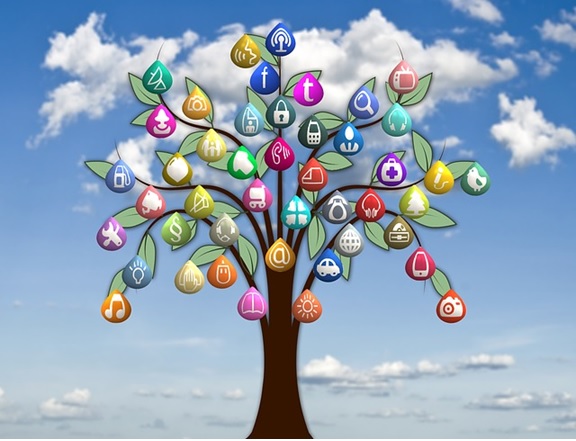
By all measures, last year was filled with earnings cycles that looked nothing like the projections. Thanks to a global pandemic and the subsequent economic meltdown, most companies wrote off 2020 early in the year.
While many radio companies actually improved their fortunes as the year dragged on, improvement was due more to budget cuts and staff reductions, rather than to actual revenue growth.
But not every brand suffered a serious downturn. In fact, TikTok, Netflix, Zoom, Peloton, and others enjoyed great years, thanks in no small part to disrupted lifestyle changes that played perfectly into their strategic plans. Each of these companies enjoyed great success, but the bones of their business were well-established well before all hell broke loose more than a year ago.
It turns out that was also true for two key divisions of Apple and Google respectively – their app stores.
According to a new study by Sensor Tower, increases in screen time last year – especially on mobile devices – were fueled by growth in app downloads and sales. And it turned out, 2020 wasn’t just a good year for mobile games and non-gaming apps – it was a record-setting year.
If you were prescient enough to develop a mobile app last year, chances are it performed well for you. They were certainly bright spots for Apple’s App Store and Google Play: 143 billion first-time installs in the year past, an increase of more than 23% from the year before.
While Google has a 3x advantage, shed no tears for Apple. When it comes to global spending on apps, it has always been advantage, Apple.
In fact, the Cupertino-based giant raked in more than $72 billion last year on apps, compared to just under $39 billion spent in the Google Play store. Since hanging out the “Welcome” sign on their App Store, Apple has taken 30¢ on the dollar for every app developed. Obviously, that has added up to a financial windfall.
Perhaps out of mercy, Apple announced last November it was cutting its commission rate for business and consumer app fees in half – to 15% for smaller developers. I’m predicting they’ll still enjoy a wildly profitable 2021 because of our love affair with apps.
Why does Apple have an historic edge in actual app revenues and profits? Tech and social guru and journalist, Lance  Ulanoff (pictured right), thinks that when it comes to apps, Apple has always been more focused:
Ulanoff (pictured right), thinks that when it comes to apps, Apple has always been more focused:
“Apple has always consolidated its apps in one store and Google Play took a while to do this (it’s still not complete). The Apple App Store is both more trustworthy and complete.”
It also has to do with the simplicity of each company’s operating systems. iOS – Apple’s mobile DNA – is the skeleton for iPhones only (along with iPads, Watch, etc.).
Google’s Android, on the other hand, powers hundreds of different mobile handsets made by scores of different companies. As you might imagine, this greatly complicates the app development and service process, affecting the uniformity and consistency of performance.
 Our mobile app development company, jacapps, opened its digital doors about 100 days after Apple opened its App Store back in the summer of 2008.
Our mobile app development company, jacapps, opened its digital doors about 100 days after Apple opened its App Store back in the summer of 2008.
Over the years, the yells of anguish I’ve heard coming down the hall have mostly come from the workspaces of the Android developers – whether they’re creating apps or trying to figure out why they’re not functioning as designed on all the different mobile devices.
So, how good was COVID for the mobile app industry? Ulanoff recently penned an article in Medium with a title that says it all: “Apps Were Our 2020 Lifeline”
He concludes that given a more finite set of options for entertainment, socializing, and gaming, many users turned to their mobile phones to solve problems, interact with others, and just kill time:
“…these (Sensor Tower) numbers prove that we acted more collectively – at least digitally than ever before. Trapped in our homes, separated from families, and our offices, we had a relatively small set of options for reconnecting.”
There’s no doubt we’ve spent an inordinate amount of time these past 11 months staring at our smart TV big screens, consuming on-demand TV, sports, and pretty much anything we could find to fight the boredom. But mobile undoubtedly had a great year, too.
 As Ulanoff concludes, “We’re just as glued to our tiny screens as we were almost 12 months ago.”
As Ulanoff concludes, “We’re just as glued to our tiny screens as we were almost 12 months ago.”
And then some. I keep getting Screen Time updates that my own personal numbers have gone nowhere but up. Many others have experienced the same metrics on their personal use of their phones and mobile devices.
Amazingly, there was a lively debate in mobile circles just a few years back about whether apps were endangered, perhaps being replaced by the mobile web.
Ulanoff recalls those days with a sense of knowing nostalgia:
“I remember when everyone thought HTML5 was going to be the foundation of all mobile apps. It was an abysmal failure. People don’t care about portability of an interface from one platform to another. They care about good interfaces on each platform and unfettered access to their data regardless of platforms.”
If anything, our love of apps has only blossomed, reaching a crescendo in the year of COVID.
Broadcasters would likely agree. As more and more consumers found themselves in listening locations without “regular radios,” mobile apps became more than just table stakes for broadcast radio stations.
To use Ulanoff’s term, for radio, they became a “lifeline.’
Over time, that’s a trend likely to continue its upward trajectory.
There is an app for that.
- What To Do If Your Radio Station Goes Through A Midlife Crisis - April 25, 2025
- A 2020 Lesson?It Could All Be Gone In A Flash - April 24, 2025
- How AI Can Give Radio Personalities More…PERSONALITY - April 23, 2025




Leave a Reply